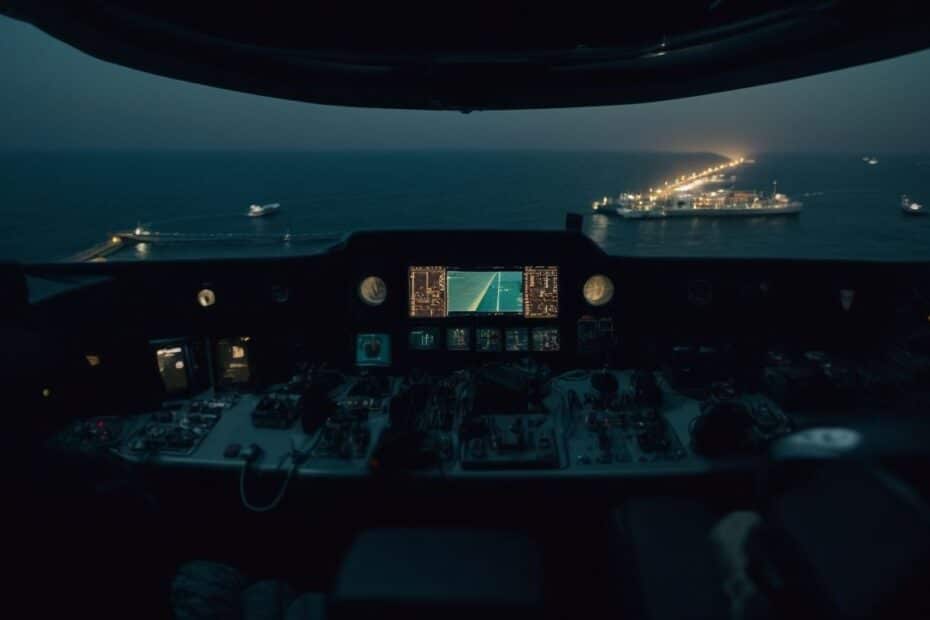Why Are Night Vision Binoculars Important for Mariners?
Night vision binoculars are a crucial tool for mariners as they greatly enhance visibility and safety during nighttime operations. These specialized devices enable mariners to navigate through low-light or dark conditions, identify potential hazards such as rocks or other vessels, and maintain situational awareness. By providing a clear view of the surroundings, even in challenging lighting conditions, night vision binoculars allow mariners to make informed decisions and avoid accidents. Investing in night vision binoculars is essential for mariners to confidently navigate through waterways and ensure the safety of themselves, their crew, and their vessel during nighttime operations.
What Are the Benefits of Using Night Vision Binoculars for Mariners?
Using night vision binoculars offers numerous benefits for mariners.
- Enhanced Visibility: Night vision binoculars provide clear vision in low-light or dark conditions, increasing situational awareness and reducing the risk of accidents.
- Extended Range: These binoculars have a longer range than the naked eye, allowing mariners to spot objects or hazards in the distance, such as other vessels or navigational markers.
- Improved Safety: By detecting potential obstacles or dangers in the water, night vision binoculars help mariners navigate safely, especially at night or in foggy conditions.
- Efficient Navigation: With night vision capabilities, mariners can maintain a steady course and avoid deviations, ensuring efficient and accurate navigation.
What Are the Different Types of Night Vision Binoculars?
Night vision binoculars come in various types, each with its own unique features and capabilities. These types include:
- Generation 1: These are the most common and affordable night vision binoculars, providing a decent level of visibility in low light conditions.
- Generation 2: These binoculars offer improved image quality and sensitivity, resulting in better visibility in darker environments.
- Generation 3: These are the most advanced and expensive night vision binoculars, offering exceptional image clarity and performance even in extremely low light conditions.
- Digital night vision: These binoculars use digital technology to capture and enhance images, providing clear visibility in both day and night settings.
- Thermal imaging: These binoculars detect heat signatures instead of relying on light, making them ideal for spotting objects or individuals in total darkness.
When selecting night vision binoculars, consider your specific needs and budget to choose the most suitable type.
How Do Night Vision Binoculars Work?
Night vision binoculars are essential for mariners to safely navigate in low-light conditions. Here is a step-by-step breakdown of how these binoculars work:
- The objective lens collects ambient light and passes it through an image intensifier tube.
- The image intensifier tube converts photons into electrons.
- The electrons are then amplified and accelerated across the tube, resulting in a brighter image.
- The phosphor screen converts the electrons back into photons, creating a visible image.
- The ocular lens magnifies and focuses the image for the viewer.
Fact: Night vision binoculars operate by amplifying existing light, including both visible and infrared light, to provide enhanced vision in low-light conditions.
What Are the Features to Look for in Night Vision Binoculars for Mariners?
When it comes to navigating the dark, open waters at night, having a good pair of night vision binoculars is essential for mariners. But with so many options on the market, it can be overwhelming to know what features to prioritize. In this section, we will discuss the key features to look for when choosing night vision binoculars for maritime use. From magnification and image quality to durability and range, we will cover all the important factors to consider before making your purchase.
1. Magnification and Objective Lens Size
When selecting night vision binoculars, it is important to consider the magnification and objective lens size to ensure optimal performance. Here are some steps to help guide you:
- Assess your needs and activities to determine the appropriate magnification level.
- Take into account the objective lens size, as it affects the amount of light gathered for improved visibility.
- For general use, it is recommended to choose a magnification of 7x to 10x and an objective lens size of 30mm to 42mm.
- For long-range viewing, it is best to opt for a higher magnification and larger objective lens size.
Remember, finding the right balance between magnification and objective lens size is crucial in achieving clear and detailed night vision.
2. Image Quality and Resolution
When selecting night vision binoculars for mariners, it is essential to consider image quality and resolution. Follow these steps to ensure optimal image quality and resolution:
- Choose binoculars with high-resolution sensors to capture clear and detailed images.
- Look for binoculars with a high-quality lens system to ensure sharpness and clarity.
- Consider binoculars with adjustable focus and diopter settings to fine-tune the image quality.
- Opt for binoculars with infrared illuminators for enhanced visibility in low-light conditions.
By following these steps, mariners can ensure that they have binoculars with excellent image quality and resolution, allowing them to navigate safely and effectively in low-light environments.
3. Durability and Waterproofing
Durability and waterproofing are crucial factors to consider when selecting night vision binoculars for mariners. Here are some steps to ensure the binoculars are durable and waterproof:
- Choose binoculars with a sturdy construction and materials that can withstand harsh marine environments.
- Check for an IPX rating, which indicates the level of waterproofing for the binoculars.
- Select binoculars with sealed and nitrogen-purged housing to prevent internal fogging.
- Consider binoculars with rubber or armored coatings for added protection against bumps and drops.
- Make sure the binoculars come with lens caps and a carrying case for safe storage and transportation.
Fact: Some night vision binoculars for mariners are designed to be submersible in water, making them able to withstand even the most extreme maritime conditions.
4. Range and Field of View
When selecting night vision binoculars for maritime use, it is important to take into account the range and field of view. The range dictates the distance you can see in low light conditions, and a longer range is advantageous for navigation purposes. The field of view refers to the width of the visual area through the binoculars. A wider field of view provides better situational awareness while on the water. It is recommended to choose night vision binoculars with a suitable range and a broad field of view to ensure maximum visibility and safety during nighttime navigation.
How to Properly Use Night Vision Binoculars for Safe Navigation?
For mariners, the ability to navigate safely at night is crucial. One tool that can greatly aid in this task is night vision binoculars. However, proper usage of these binoculars is essential for their effectiveness. In this section, we will discuss how to properly use night vision binoculars for safe navigation. This includes familiarizing yourself with the equipment, practicing in different lighting conditions, and using proper techniques for holding and focusing the binoculars. By following these guidelines, mariners can ensure their night vision binoculars are a valuable asset for navigating in the dark.
1. Familiarize Yourself with the Equipment
Familiarizing yourself with night vision binoculars is crucial for safe and effective use. To ensure proper usage, follow these steps:
- Thoroughly read the instruction manual to understand all the features and functions of the binoculars.
- Practice using the binoculars in various lighting conditions, such as dusk or nighttime, to become comfortable with their performance.
- Adjust the focus and zoom settings to ensure clear vision and appropriate magnification.
- Learn how to hold the binoculars steadily to avoid shakiness and maximize stability.
By following these steps, you can confidently use night vision binoculars and improve your safety on the water.
Remember to always choose binoculars that meet your specific needs and preferences, considering factors like magnification, image quality, durability, and waterproofing. Stay informed and make informed decisions when selecting your equipment.
2. Practice Using the Binoculars in Different Lighting Conditions
To effectively use night vision binoculars in different lighting conditions, follow these steps:
- Adjust the binoculars’ settings to match the ambient lighting, such as using a lower intensity setting in well-lit areas and a higher setting in darker conditions.
- Practice Using the Binoculars in Different Lighting Conditions by scanning different environments, such as open water, wooded areas, or urban landscapes, to become familiar with how different lighting affects visibility.
- Experiment with different filters or lenses that can enhance or reduce light, based on your specific needs and preferences.
- Learn to identify and interpret different light sources and their impact on visibility, such as direct light, reflected light, or low-light conditions.
- Regularly practice using the binoculars in various lighting conditions to develop proficiency and adaptability.
3. Use Proper Techniques for Holding and Focusing the Binoculars
Using proper techniques for holding and focusing night vision binoculars is crucial for optimal performance and clarity. Here are some steps to ensure you’re using them correctly:
- Hold the binoculars with both hands to stabilize them.
- Keep your elbows close to your body to minimize shaking.
- Use your non-dominant hand to adjust the focus wheel, ensuring a sharp image.
- Position the eyecups at the correct distance from your eyes for comfort and to reduce light leakage.
- Avoid touching the lenses to prevent smudges and damage.
- Experiment with different grip positions to find the most stable and comfortable one for you.
By following these techniques, you can enhance your viewing experience and make the most of your night vision binoculars.
What Are the Safety Precautions for Using Night Vision Binoculars on a Boat?
Using night vision binoculars on a boat can greatly enhance safety during nighttime navigation. However, it is important to follow certain precautions to ensure their effective and safe use. These safety measures include:
- Familiarizing yourself with the device: It is crucial to read the instruction manual thoroughly to understand the features and operation of the binoculars.
- Securing the binoculars: To prevent accidental drops and ensure easy accessibility, it is recommended to use a strap or harness.
- Adjusting the focus: Properly setting the focus is essential to avoid eye strain and ensure clear vision.
- Avoiding bright lights: Exposing the binoculars to bright lights can damage the image intensifier tube, so it is important to avoid doing so.
- Keeping a lookout: It is important to maintain visual awareness of your surroundings and use the binoculars intermittently.
By following these safety precautions, mariners can fully utilize the benefits of night vision binoculars while ensuring a safe voyage.

From the gentle rustling of leaves to the distant chirping of birds, the outdoors has always been my sanctuary. With an innate love for nature, I find solace in the embrace of the wilderness. Whether hiking up scenic trails or simply taking a stroll in the park, the outside world offers endless wonders to discover.
But of all the outdoor activities, bird watching is special. Armed with a trusty pair of binoculars, I spent countless hours observing the magnificent dance of birds in their natural habitat. The thrill of spotting a rare species or simply appreciating the beauty of common birds in action is an experience that never gets old.
For me, binoculars are more than just an optical tool; they are a gateway to a world often overlooked. Every glance through those lenses is an opportunity to connect, learn, and be mesmerized by the avian wonders of our world.

